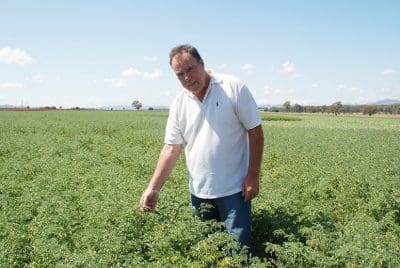CAPITALISING on the yield potential of a chickpea crop can be reliant on one simple letter – ‘P’ for phosphorus.

NSW Department of Primary Industries (NSW DPI) senior research agronomist Dr Andrew Verrell says understanding a crop’s P requirements is a critical first step in maximising crop yield potential and can deliver long-term benefits to the farming system. (Photo: NSW DPI)
NSW Department of Primary Industries (NSW DPI) senior research agronomist Dr Andrew Verrell said adequate phosphorus (P) availability was essential to the productivity of chickpeas as soil P levels influenced the crop’s ability to produce biomass, flower and set pods.
“The older red duplex soils are inherently low in P compared to the vertosols, and most growers with these soil types would be applying P as part of their routine management,” he said.
“In situations where growers aren’t currently applying P and don’t think there’s a need to, they can check by putting in test strips of P applications.
“The crop response in the test strips can be assessed physically and visually and then compared to the rest of the crop where P hasn’t been applied.”
Dr Verrell said understanding a crop’s P requirements was a critical first step in maximising crop yield potential and could deliver long-term benefits to the farming system.
“The simple fact is, if you grow a crop that’s deficient in P, it will reduce yield potential as well as creating a knock-on effect for the following cereal crop,” he said.
“Without adequate P, the crop won’t produce enough biomass and there’s a strong link between biomass and nitrogen fixation.
“If you aren’t producing enough biomass, you’re robbing yourself of nitrogen and preventing the crop from having a meaningful impact on some of the cereal diseases.
“It’s critical to ensure that the nutritional requirements of your crop are being met to maximise potential yield under the operating environmental conditions. If you get that right, then the whole cropping system will start to hum along.”
Source: GRDC, https://www.youtube.com/watch?v=eDGR6MmsFu0&feature=youtu.be

HAVE YOUR SAY